The Year In Crosswords, 2022
Tired: 280 characters. Wired: 5 characters X 6 guesses.

Wordle in, Twitter out. The year began with a delightful game and a burst of wild enthusiasm; it ended with a depressing scandal and a burst of bad-faith arguments (guest-starring Donald Trump, Jr…but I repeat myself). The game is likely to matter more to our scene in the long run, and it’s more fun to talk about. But we’ll get to both.
Before we dive in, caveats and promotions. Sign up for my newsletter to follow the rollout of Ubercross Alphabetica, my newish project that might be part of this roundup next year.

And then…forgive! Because I’m just one guy putting this together in my free time. (As ever, please put anything I’ve missed in the comments.) And while I try to explore the cross-world in some detail, the biggest kinda-sorta crossword story of the year presented me with a special challenge.
Yes, yes, it’s not exactly a crossword…but on the other hand, it’s got words, it’s got a grid. The grid’s horizontals and verticals interrelate in a puzzlific way. So it’s close enough to count, for me. But on the other other hand, I only have room to scratch the surface on this topic, or else it’d drown out everything else on the list. That’s right…
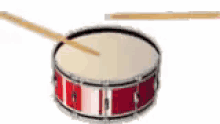
It’s A Wordle, Wordle, Wordle World
Already a trending topic in late 2021, Josh Wardle’s gift of love to Palak Shah took the internet by storm in 2022. The game spawned an entire genre of imitators and a cottage industry of articles on everything from major dictionaries to everyday philosophy. Twitter timelines filled up with people posting their Wordle-maps (like Jimmy Fallon’s, above).
Wordle kept thriving after its acquisition by The New York Times, which used Wardle’s word list for over ten months and didn’t even integrate it into its own app for six. However much we wanted to blame the NYT, even the notorious streak-breaker PARER was one of Wardle’s, and the hot-button timing of FETUS was an unfortunate coincidence (the NYT did change that one for some, but not all solvers).

After November 8, the game’s word list became a bit less plural-friendly and experimented with “intentional” answers on Thanksgiving weekend (DRIVE on Wednesday, FEAST on Thursday). So far, though, the Times has been a stalwart steward of the game: its first Wordle year was a far smoother ride than its 81st crossword year (…but we’ll get to that). Its only real misstep, Wordle-wise, has been teaming with Hasbro to release a board-game edition. Professional reviews suggest that game is…not great.
Wardle, honored by Time and a few million dollars richer, enjoyed retreating from the public eye…though he did host the first live Wordle competition at the ACPT and grant a video interview to Will Shortz.
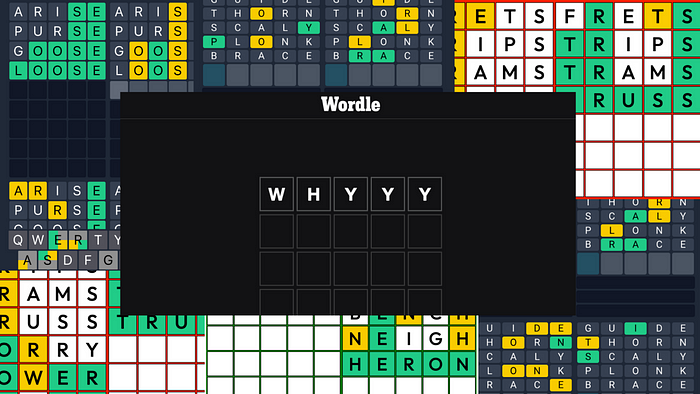
Wordle variants abound in many alphabetic languages and subject matters, from French to “Aussie,” from addition to Yu-Gi-Oh. The largest lists I could find were here and here. Crosswordle by Jeff Davidson is the most “crosswordish” variant of the lot, but I have a soft spot for the crossword-formatted Waffle (more a jumble than a letter-guessing game) and the self-explanatory Phrazle. (I’m seeing a lot of buzz about Knotwords, too.)
What’s the best start word? Wordlebot itself goes with CRANE or SLATE. (The link says CRANE, but my last encounter with WordleBot says SLATE.) MIT researchers and data-loving YouTuber 3Blue1Brown picked SALET, albeit using Wardle’s list as their data set. Bill Gates suggested AUDIO.
Kotaku can’t challenge those authorities, but its suggestion that XYLYL is the worst possible start word seems legit. (For best, it went with LATER.)
Uri Bram and cruciverbalist Nate Cardin had further ideas on strategy, some of which Cardin may have repurposed for his Wheel of Fortune win.
For those who were online in the mid-1990s, Wordlemania felt like a return to the old World Wide Web, with its optimistic, intellectual culture, when the arguments were cheeky and most everyone understood the stakes of those arguments were low. While the craze has cooled since the heady days of last winter, Wordle remains a bright spot in word lovers’ lives.
And they needed that bright spot when…but we’ll get to that.

Publishing Moves
Bigger: The New Yorker expanded to offering crosswords every weekday. As promised, the American Values crossword enjoyed a similar expansion. New York/Vulture added a daily 10X10 crossword by Malaika Handa and Stella Zawistowski. USA Today added a two-minute mini puzzle.
Smaller: The Washington Post published five crosswords by women, one for each Wednesday of Women’s History Month. On a more worrisome note, it cut its long-running magazine section — not cutting Evan Birnholz’s puzzle feature, but moving it from its original home.
New Leadership: The Los Angeles Times has a new crossword editor, Patti Varol. Crucinova, rescued from cancellation, will continue under new owner-editor Quiara Vasquez.
Diverser People: The New York Times announced the first class of its Diverse Constructor Fellowship Program and took applications for a second class. Graduates of the inaugural class Kanyin Ajayi, Helen Chen, Trey Mendez, Gustie Owens, and Ailee Yoshida all had their NYT debuts this year.
Diverser Content: The NYT also launched a Games-focused newsletter, Gameplay, and tinkered with a couple of short-lived features like The Lab (examining non-NYT crosswords) and Clued In (exploring facts behind common puzzle answers like BRA and the history of their mentions in puzzles). But its most creative innovation this year? Crossword socks.
Perspective: Luke Winkie for Nieman Lab analyzed the current, flourishing relationship between news outlets and puzzle features.
New Features in 2022: A Little Puzzling, The Amherst Student (campus), Atlas Obscura (for the geographically inclined), Autostraddle (a publication known for its sex-positive and LGBTQIA-friendly content), The Bluffton Icon, The Buzzle Blog (cryptics), The Chicago Maroon (campus), The Courier (campus), Crossword Club (email and web), Crossword Jigsaw (just what it says), Completing the Square, Crossword Dilemmas (new URL), Cruciverbology (“Crosswords with a nerdy twist”), The Indian Express (now online), The Irish Times (subscriber-only), My Jewish Learning Puzzle, Killer Crossword (more of a fill-in criss-cross but an interesting variant), Pix Puzzles (cryptics), Playbill (for theater lovers, mostly print-exclusive), Plymouth Live (regular and cryptics), Quid Pro, The Rackenfracker (cryptics), The Red and Black (campus), Square Chase (Patreon, cryptics) Telegraph Puzzles (including Cross Atlantic crosswords and PlusWord), and Xtra Xword with Ada Nicolle — possibly the first trans constructor in charge of an outside publisher’s crossword feature.
New-ish: The New York Sun’s revived feature is running old Peter Gordon puzzles alongside new material. And the Omaha World-Herald puzzle (print) has returned from cancellation.
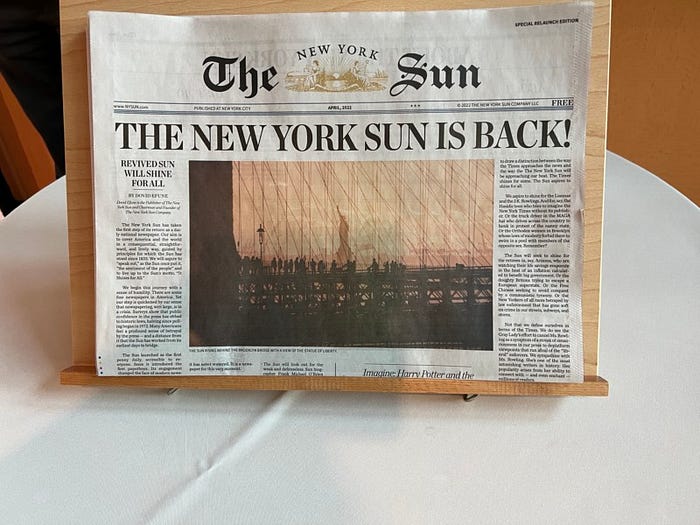
New AND Cancelled: LEO ran a cryptic crossword feature by Trip Payne for a while this year, but Payne reported it stopped after seven installments with the August puzzle.
Note: News about cancellations can be spotty. Crossword features, especially campus or web-based ones, tend to start with a bang and end without even a whisper. Maybe this is something for Daily Crossword Links to look into (shout-out to its new URL!)…or maybe I’ll do more with it next year. I’m sure I’ll have more time then! (Rim shot, forced laughter.)
Crowdfunding
The Honeypot Puzzle Fragments by Parker Higgins and Ross Trudeau, a “compact zine of crossword puzzles and a work of historical fiction,” was the biggest single Kickstarter of the year with $7590 in earnings.
Crosswords for a Cause raised money for Sharp Again Naturally, a cognitive-health nonprofit.
Erik Agard did some personal fundraising for the family involved in this ACLU-championed case.
Peter Gordon’s A-to-Z and Fireball Newsflash series will continue into the new year.
These Puzzles Fund Abortion had a second wave this year, and a third is coming. Profile here.
Tourneys
The American Crossword Puzzle Tournament returned to in-person meeting this year, as did many other tourneys, and Tyler Hinman came up from third to get his seventh win. This was also the tournament’s first livestreamed year and first year with simultaneous in-person and virtual tournaments. The ACPT itself has set up a great repository of digital resources if you’d like to find out more about the 2022 event.
You may also enjoy two personal accounts from competitors who bravely acknowledge their failings: Good Housekeeping’s Barbra Bourland and…Tyler Hinman. Video of the final round is below.
I usually don’t have detailed reporting to offer on tournaments outside the ACPT. Hayley Gold’s Lollapuzzoola writeup is a welcome exception.
Boswords results: Winter, Spring, Summer, Fall.
The literacy-promoting Finger Lakes Crossword Competition returned in virtual fashion, including Will Shortz, Anna Shechtman, Rex Parker, and Deb Amlen as guests. Westport Library’s Annual Crossword Puzzle Contest features Will again this year.

Erik Agard and Neville Fogarty turned up in the Global Indian Crossword League contest, but victory went to seven-time winner Ramki Krishnan. India’s National Inter-College Crossword Expedition (NICE 2022) crowned IIT Delhi as the final champion for its first annual competition. Kuhu Goel and Ashish M. from DPS Pune won “CCCC,” India’s national high-school-level contest, for the second year in a row. Why so many crosswords in India? Ria Chopra reports India’s teens love the heck out of ’em.
Goshen College student Caleb Shenk won the MyCrosswordMaker $1,000 “scholarship.” Interview here, samples of his work here.
Records
Animation: The New Yorker has an animated cover (below) with accompanying puzzle that refers to it. Obviously, some will solve the puzzle using the print version of the cover. Even with this caveat, this is the first “animation-interactive crossword” I’ve seen. Animation by John Kuramoto, crossword by Paolo Pasco, and original art by Chris Ware. Ware gives a charmingly befuddled interview about it here.
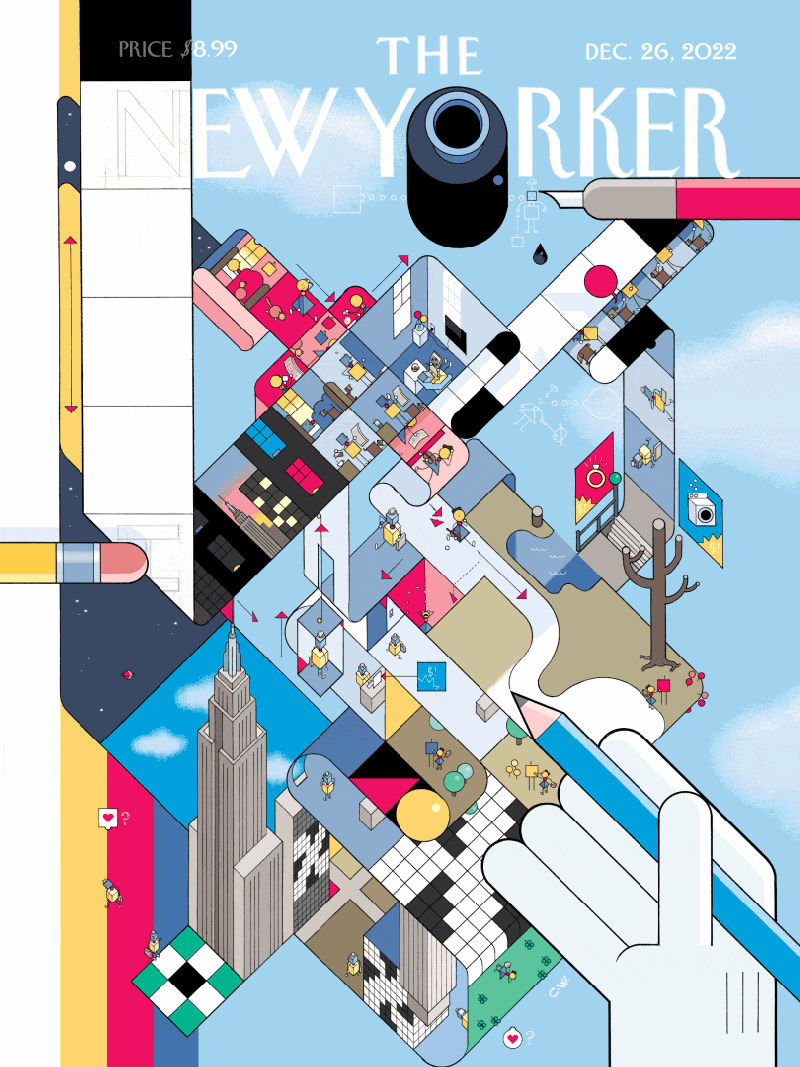
Size of Collaboration: Could this 20-collaborator puzzle and its 19 feeder versions (“Tabula Rasa,” coordinated by meatdaddy) be the longest byline in crossword history?
Collabs are big this year. Lemonade Disco is a monthly crossword suite: volunteers compose contributions in response to a prompt. Enigmarch may well become the puzzler’s version of National Novel Writing Month. MyCrossword, discussed at The Guardian, is an emerging open-source crossword-sharing hub, a bit like the British answer to Crosshare.
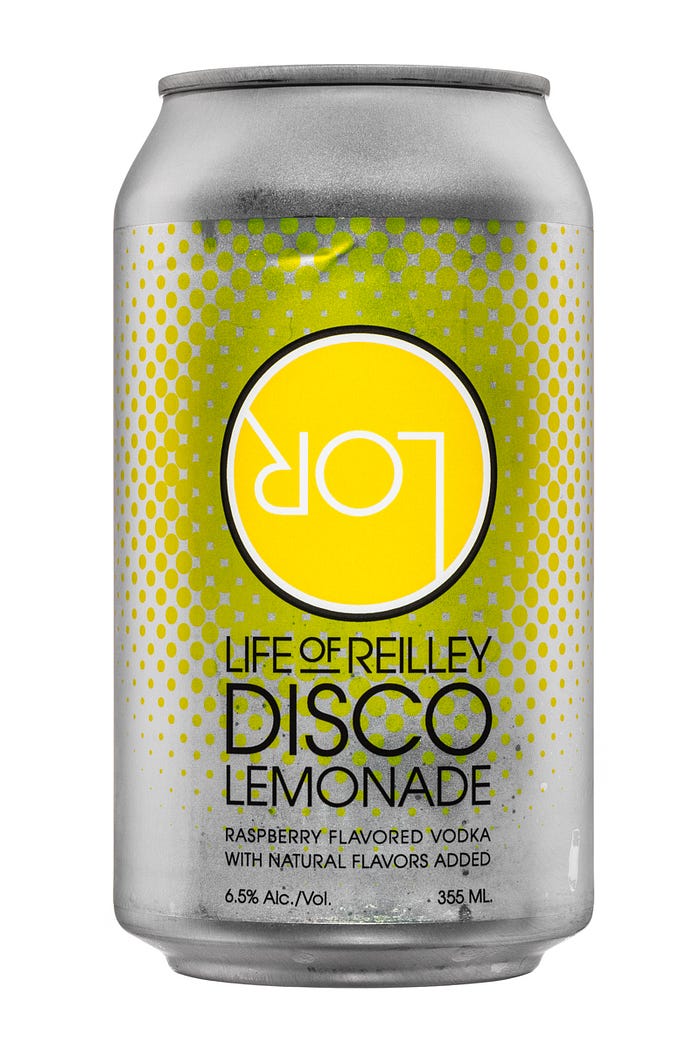
Most Guardianness: The Most Guardian Crossword Ever. Also, The Guardian published a crossword with all its across clues multitasking. That’s 25% or 50% duplicate content, depending on how you count it.
3-D: This is not the first 3-D crossword by a long shot, but it is a unique design, inspired by Star Trek’s tradition of three-dimensional chess.
Longest Documented Solving Streak: I can’t say for sure it qualifies, but this 1461-day/four-year stretch did raise my eyebrows. (This year, some solvers did break their crossword and Wordle streaks for labor-support reasons.)
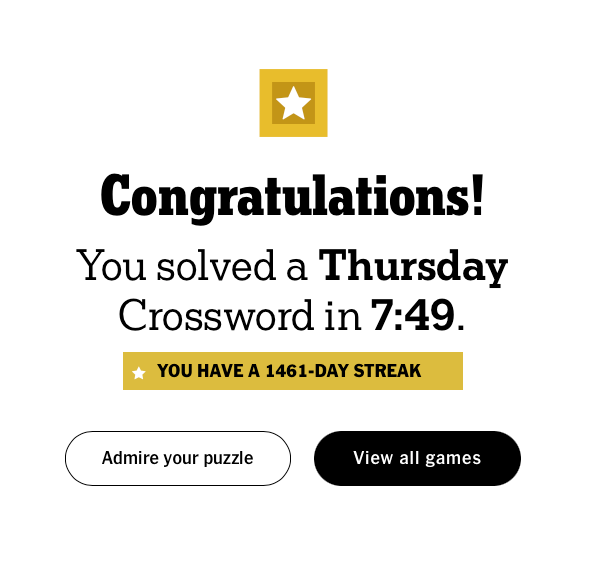
AI: The first widely published AI-generated crossword puzzle was built by ChatGPT, guided by patient human Nayanika Mukherjee. GPT wrote the inaccurate clues and answers (see below — ostriches are omnivorous and African, hula hoops do not have numbers, etc.) and Mukherjee did her best with the grid design. Humans can relax on this front for a little while yet.
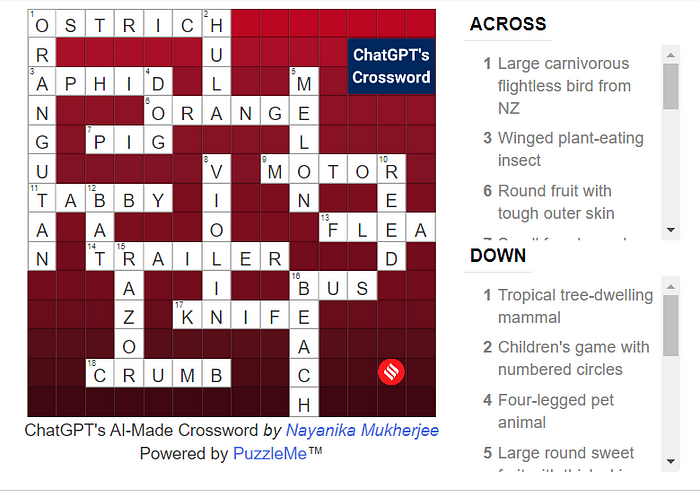
Software
Remember the issue with NYT puzzles no longer being downloadable? Crossword Scraper lets you get .puz or .jpz files from NYT and most sites with crosswords. You can download it here or learn more information here.
Xword offers a more JPZ and IPUZ-friendly alternative to solving programs like Across Lite. So do the web-based squares.io and Nexus Solver.
Crossword Compiler rolled out new features for Version 11.1 (video). XWordInfo upgraded its puzzle-analysis feature. Adam Aaronson and others are developing another grid-filling program, Swordsmith, currently open-source.

If your ambitions or budget are smaller, you can build basic crosswords in Excel, Google Sheets, Illustrator, and PowerPoint. You can also model a solving experience in Articulate Storyline 360 for e-learning purposes.
The Expanded Name Database did some expanding this year, as creator Erica Hsiung Wojcik discussed. Spread the Wordlist did some too.
Alex Boisvert developed an Acrostic Generator and YouTubed a guide to using it. He also has tools for making decoupled-clue crosswords, spiral and snake charmer puzzles, and “Onion clues.”
Inspired by Quiara Vasquez, Boisvert also developed a new program that calculates constructors’ Salomon numbers. What’s a Salomon number? Well…ever played Six Degrees of Kevin Bacon? The late Nancy Salomon may have been the nexus of crossword collaboration, and this is a cool way to honor her. The tool can trace collaborative links between any two constructors in its database, and Boisvert’s published some initial findings.
The Robots Are Coming! The Robots Are Coming!:
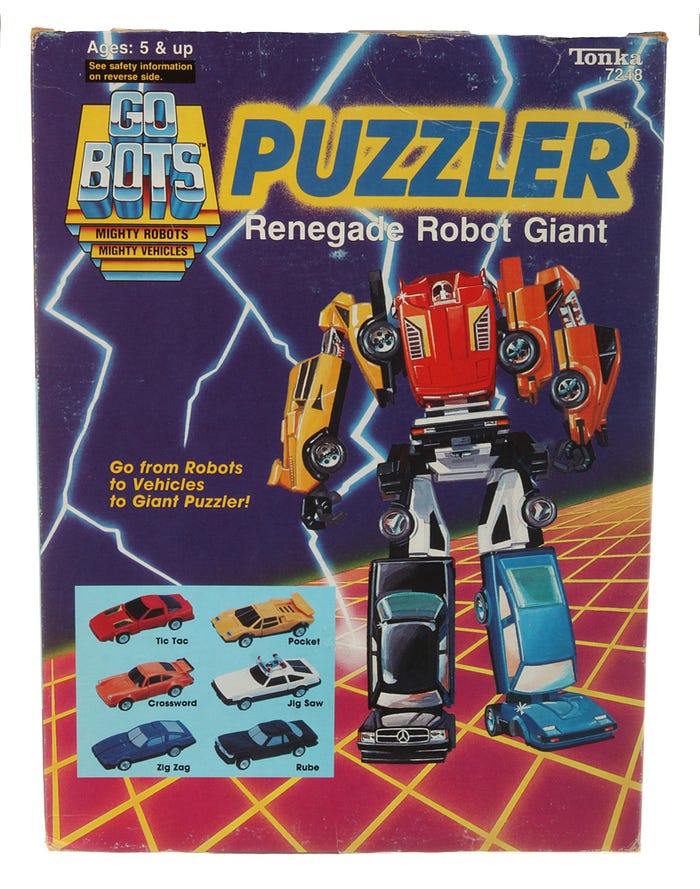
In AI-solving news, the Berkeley Crossword Solver “won” the in-person American Crossword Puzzle Tournament for the first time, outperforming all human contestants. However, crossword puzzles are not yet “solved” like tic-tac-toe and chess. BCS is 99.7% letter-accurate and 82% puzzle-accurate for the New York Times crossword, less so for other styles (it’s hopeless against cryptics, and the more theme-based a puzzle is, the worse it does). You can demo the program here and read the paper behind it here. One of the authors is Matt Ginsberg, who created BCS’s predecessor, Dr. Fill.
Also of note is the bilingual robo-solver Webcrow 2.0. As explained here, it works in English and Italian. It beat all comers in an on-site challenge but still lagged behind five Americans and three Italians in online trials. And on the pure-science side of things, eight researchers published “Crossword Puzzle Resolution via Monte Carlo Tree Search.”
Cross-Media
Books: The puzzle-lover’s book of the year is A.J. Jacobs’ The Puzzler: One Man’s Quest to Solve the Most Baffling Puzzles Ever, From Crosswords to Jigsaws to the Meaning of Life. Though it goes far beyond crosswords, Jacobs’ journey began with Jacobs finding himself in the NYT grid — first on a Saturday, then (more satisfyingly) on a Tuesday.

Other books of interest: A24’s 99 Movie Crosswords (see review), 9 Down Is Dead (a murder mystery with a crossword-loving killer), the first Inkubator collection, and Jeff Chen’s The Best Puzzle Book for Adults.
Theater: Yale students’ play Word Nerd, about a cruciverbalist TV personality who comes to a moral crossroads, was previewed at the ACPT and shown in full on campus.
Film: Michael Vlamis is directing and starring in Crossword, an upcoming psychological thriller about “a young married couple coping with the loss of their daughter. While Tessa trudges forward, focused on her bestselling children’s book series inspired by their daughter, James tries to find solace in the daily crossword. As the crossword takes on a mind of its own, the seams of the couple’s reality begin to unravel…”

Judi Dench used crosswords to understand her latest role. But Rian Johnson did his best mystery-directing by defying the crossword metaphor.
TV: The CBC’s documentary Across and Down covers the activist side of crossword culture.

Not TV, but related to the doc: Portia Lundie, Celia Mattison, and Erica Hsiung Wojcik on how the struggle to diversify affects them. Solver Greg Moore, a Black man, says the effort has brought a safe space to his life.
Stranger Things started its season 4 with ex-villain Brenner filling out a crossword that fans have hunted for Easter eggs and hints to the show’s wrap-up in Season 5 (more here). The names of older ST characters do appear. Kali from Season 2 is hidden in KALIS, and there’s the odd appearance of both BARBARA STREISAND and BARBARA STANWYCK. There was a Barb in the first episodes of the show, but she was an early fatality. Her body was discovered and they had a funeral and everything. So…Season 5 couldn’t have anything to do with her…right? Still, it’s a strange thing for a puzzle to have…two Barbaras…

Game show People Puzzler has been renewed, but the Crossword Mysteries series seems unlikely to continue. They resolved its meta-mystery and romantic arc, though, so that’s something!
A failure to solve brought some drama to Big Brother Nigeria.
YouTube: Stella Zawistowski took on hundreds of solvers combined and almost won in the “Game On” video below.
Music: J. Maya’s lyric video for “Sunday Crossword” is beautiful…if a little frustratingly inconsistent with the crossword imagery in the song.
The video for “The Astronaut” (featuring Jin of BTS) uses a crossword to send a little love to BTS fans (by including the word ARMY). (Jin is likely to “blast off” away from BTS before much longer.) A sweet message…
…even if, as TikTokker Gong Studios points out, that’s not really how crosswords work. (Tap the “audio” button at the lower left-middle if you’re having trouble.) “Why you lookin’ at me like that, like you did something?”
Somewhat similarly, Xiumin of the boy band EXO used (and abused) a crossword in his video for “Brand New.”
YT Shorts: Internet personality Pokimane attempts to play Wordle and then tries again, to the delight of millions. If Crossword Puzzles Were Southern. Dad joke disguised as mother-son moment.
Game Reviews: Pure Crosswords for Nintendo Switch: download here. Kryss: The Complete Scandinavian-Style Game: download here. And Make Tech Easier reviews nine established crossword apps.
Advertising: Hertz? Hertz. (…Hurts.)
Twitch Streamers of Note: Cursewords, Crossweird TV, Tyler Hinman, Will Nediger, JibbyMAX. YouTube Solvers: Cracking the Cryptic, Chris Remo.
Widely-Discussed Clues (Fun Edition)
“Why do they call it ___ when you of in the cold food of out hot eat the food?” (internet meme) (OVEN, USA TODAY)
Sandra Bullock movie that Homer calls “The Bus That Couldn’t Slow Down” on The Simpsons (SPEED, The Atlantic)
“you’re telling me a cis ___ built this chapel?” (@RileyJohnSavage tweet) (TEEN, USA TODAY)
D-worthy (POOR, NYT)
Astros, in the 2021 World Series (LOSERS, USA TODAY)
Nut in a Thanksgiving pie (PECAN, NYT Mini)
Odds and Ends
Rankings: Dylan Cohen ranks the NYT puzzle genres.
Jingles: Christianna Silva reviews the NYT crossword’s “good job, you did it” music. Reductress also has a (raunchy) tribute to the tune.
Famous Solver: Kate Middleton, whose struggle with “Sovereign’s annual allowance” (CIVIL LIST) revealed that she didn’t spend too much time thinking about the Queen’s money. That probably reflects well on her. Runners-up: The Atlanta Braves, Melissa Benoist, and Kamala Harris.
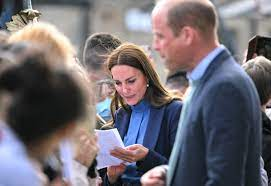
Crosswords and Love: Jayne Tuttle shares her courtship story. David Steinberg aided Jackson Roberts with a “promposal” to Evie Stull, which might’ve influenced Steinberg’s realignment of his own priorities in life and love. A mother and her OCD-stricken son bonded over crosswords, too.
Holidays: December 8 is now National Crossword Solver’s Day, while Raleigh Parks did more to observe December 21, Crossword Puzzle Day.
Humor: “It’s Becoming Clear That the Crossword Constructor Is Going Through Something.” Also: “If Dogs Played Wordle.”
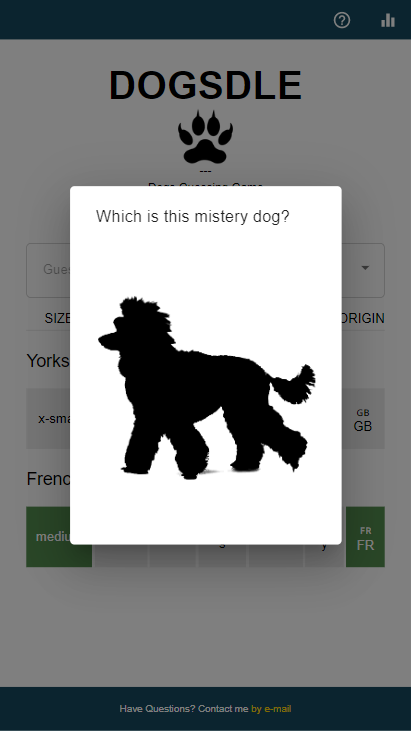
Scholarship
Raw Data: George Ho’s datasheet of half a million cryptic crossword clues is imperfect in some respects (I don’t agree with what he classifies as “insertion” versus “container,” for instance). But it’s still a massive trove for anyone trying to figure out how cryptics really work. He also has a roundup of dictionary resources for crossword-makers.
Literature: Torquemada and Ximenes, key figures in the history of British cryptics, got a posthumous spotlight this year. T.S. Eliot, Torquemada, and the Modernist Crossword,” by Roddy Howland Jackson, puts cryptics in a history-of-literature context. And the classic and out-of-print “Ximenes on the Art of the [Cryptic] Crossword” is now available here.
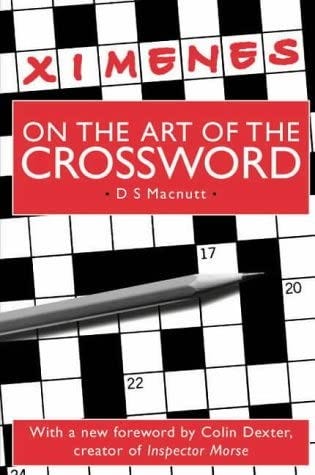
Cybersecurity: What Editing Crosswords Can Teach Us About Security Leadership…and about programming.
History: Ben Zimmer on “How Cryptic Crosswords Crossed the Atlantic.” Adrienne Raphel charts the history of the Fifteen Puzzle and its odd similarities to the later crossword and Wordle crazes.
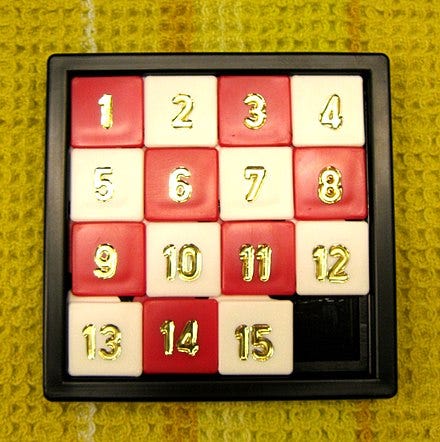
Ethics: “C-H-E-A-T: Wordle Cheating Is Related to Religiosity and Cultural Tightness” by Alexandra S. Wormley and Adam B. Cohen. Abstract (and article for pay) here, summary by one of the authors here.
Economics/Sociology: New Republic’s Matt Hartman surveys the crossword labor market and the successes and failures of efforts to promote diversity.
Profiles and Self-Profiles
Adam Aaronson, Azed, Rob Baker, Buccaneer, Jeff Chen (there and on Spotify), Gayle Dean (retired), David Ding (self-profile), Eccles, Everyman/Alan Connor, Sam Ezersky (video), Vic Fleming (blurb), Sue Fracker, Matt Gaffney (video), Jess Goldstein, Hayley Gold (radio), Col Deepak Gopinath, Tyler Hinman, Donna Hoke (self-profile), Christina Iverson, Julius, August Lee-Kovach, Adam Levine, Aimee Lucido, The Magpies, Ron Major, Sophia Maymudes, Pete Muller and Andrew White, Professor Serpent, Phssthpok, reviewer Jim Quinlan (interview by Evan Birnholz on Quinlan reviewing Birnholz’s puzzles), Anna Shechtman (and again on the BBC), Caleb Shenk, Will Shortz (short video), Dave Shukan and David Kwong, David Steinberg, Mary Tobler, David Tufts, Steve Weyer, Yacob Yonas, and Zamorca. Plus: The NYT has a new-constructor list.
RIP: Jeremiah Farrell, author of the famous “Election Day” puzzle featured in Wordplay and editor of Word Ways: The Journal of Recreational Linguistics. A few years back, Farrell wrote a special crossword for Word Ways called “The Puzzle of My Life.” The three longest entries in the grid below are a single answer paired with the clue, “‘When I ___’ (my life story).”
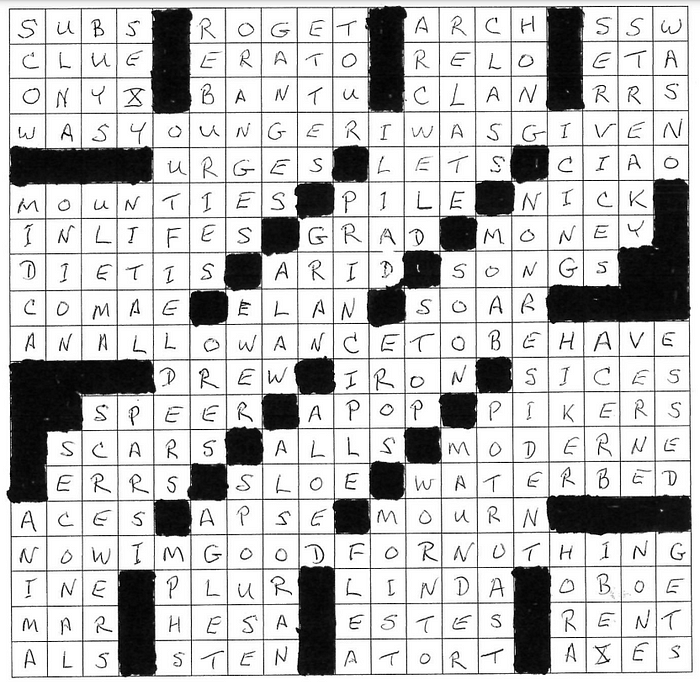

Crossword Twitter
The most popular and interesting crossword tweets of the year — excluding the last couple of weeks, in which crossword tweets have been all about…(sigh) We’ll get to it. Let’s just say the bird app was bad at dealing with controversy even before its current state of muskiness.
See you next year, when this section will be renamed “Crossword Tumblr,” “Crossword Discord,” or “Crossword Mastodon,” I guess?!?!?!?!
Best “Hey, I’m A Crossed Word” Reaction:
Wordle Twitter
Controversies
As mentioned above, the NYT managed to run Wordle better than almost anyone expected. So I’d like to congratulate the paper’s entire Games staff on a profitable year spent bringing solvers nothing but joy! Yes, I’d…like to do that…buuuuut…
Buckle up, guys. The rest of this roundup is gonna be rough.
Controversial Clue/Answer of the Year: The NYT probably hoped this would be the playfully “controversial” centerpiece of their “Sci-Fi Showdown” puzzle. “The better of two major sci-fi film franchises?” could be STAR WARS or STAR TREK, depending on crossings.
But the real controversy came a month earlier with “Greener energy source” (CLEAN COAL, New York Times). According to puzzle author Lynn Lempel, her original clue was “Dubious term for a greener energy source.” The Times issued a correction the next day.
Runners-up: “Slow down” (RETARD, Wall Street Journal…the objection to this should need no explanation), “Irish ____, popular St. Paddy’s day cocktail” (CAR BOMB, New York Times…none too popular in Ireland), “San Francisco’s metro” (BART, NYT Mini, called out as incorrect here).
Controversial Constructor of the Year: Tina Labadie — that is, David C. Duncan Dekker. Dekker had been an NYT contributor before his post-publication flame wars with solvers alienated Will Shortz. (He’s appeared in other papers as well, though not recently.) In 2022, the NYT published his “Letterplay” Sunday crossword under the name Tina Labadie…probably to Shortz’s chagrin after he realized who “Labadie” really was.
Dekker’s unhinged behavior since being unmasked is unlikely to win him friends among newer editors, either. Among his claims, past and present, were that no one else had the right to use his unfilled grid designs and that the NYT and its crossword belonged to “the Global Editor.” (I link to this Fiend thread and partly redacted Reddit thread if you really need to verify.)
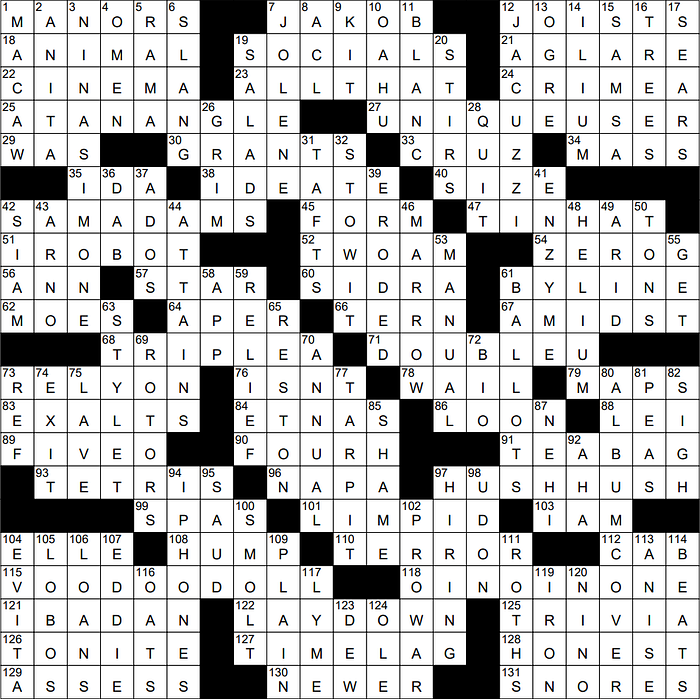
Dekker’s…worldview aside, I have to add: his newest was the sloppiest NYT Sunday I’ve seen in years. Did everyone think it was good design to mix one altered theme entry (_OIN_, _OIN_, _ONE, playing off ZERO-G) with a stack of unaltered ones? ROLLIN’ ROLLIN’ ROLLIN’ and similar phrases also have ZERO G’s… Did nobody realize UNIQUE USER, meant to play off DOUBLE-U, has three U’s, not two? (You could count initial letters only, but that would ruin VOODOO DOLL/FIVE-O and HUSH-HUSH/FOUR-H…)
The elephant in the room is that multiple reviewers welcomed “Tina” as a new female constructor before “she” was revealed as Duncan. Dekker apparently claimed he never replied to messages about the puzzle after its acceptance. While he is a dubious source, it does seem likely no one took any steps to verify “Tina’s” identity.
This is a thorny problem for diversification. Pseudonyms are standard practice in British puzzles and hardly unknown in America. So what’s to stop another bad actor from submitting as “Kelsea Ngongo (she/they)” when they are in fact a white male named (hypothetically) Harry Smith IV?
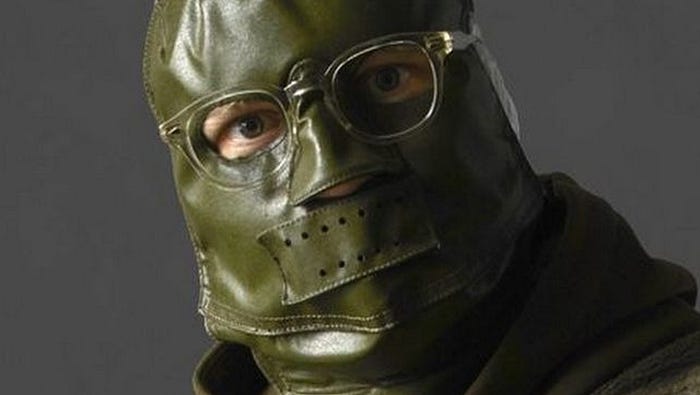
The crossword community is a highly moral one, so I doubt submissions like that are common. But when something like this happens, preventative measures need to follow, or else it will happen twice.
Controversial Grid of the Year: The NYT’s December 18 grid struck solvers as shamefully swastikaish, especially for the first eve of Hannukah.
This became a high-stakes Rorschach test. Some reported that they and all their friends saw the shape right away, whereas others (including all of the usual reviewers and, presumably, NYT Games staffers) didn’t see it at all.

There are two kinds of protest we need to deal with here. The first recognizes this as disastrous, sometimes traumatizing, but accidental. “Accidental” does not mean “not to be addressed.” When something like this happens, preventative measures need to follow, or else…
Oh, for God’s sake, it already has happened twice. And the offending grid from five years ago was far less swastika-like than this one. (Kim LaCapria argues a possible third case in the Minis.)
A Times spokesperson called the puzzle “a common crossword design…many open grids in crosswords have a similar spiral pattern because of the rules around rotational symmetry and black squares.” In a general sense, that’s true. But I’ve flipped through XWordInfo’s grid collections, and the 12/18/22 grid does seem more swastika-like than any other in NYT history.
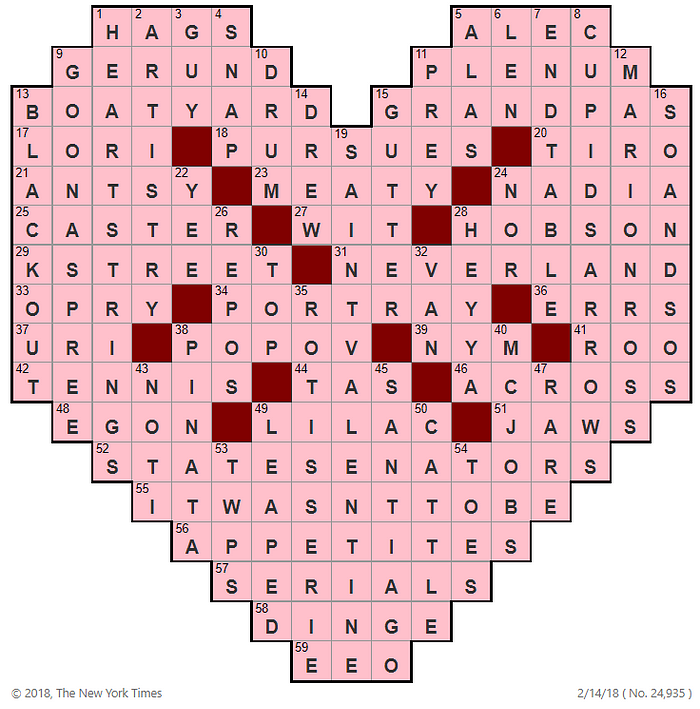
That may raise your eyebrows. It may make conspiracy theories sound more attractive for a minute. But the real explanation for it is rooted in abstract (i.e., boring) issues of design.
Puzzles unconstrained by theme can be more “wide open.” Sunday puzzles, with their greater “pixel resolution,” are better at looking like specific objects than 15x15 grids are. And the NYT only reintroduced occasional themeless Sundays four years ago. The last time Sunday themelesses were a thing, crossword-constructing software was nonexistent and arty grids rare. Puzzle author Ryan McCarty was devoted to exploring wide-open grids — or “gaping maws,” as he named them. And I know from personal experience that a diagonal “river” of words is a useful feature in large, wide-open designs — contrasting diagonals, even more so.
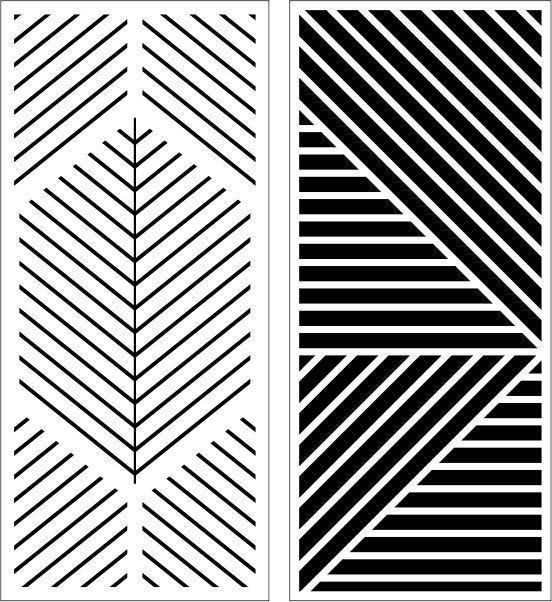
As Dekker has proven, crossword constructors can have odious opinions. But McCarty as a Nazi ally is wildly implausible, and it gets more so the more you study him and his puzzles. In the above-linked interview, he said, “I would never put KKK or KLAN in a puzzle.” His clue for FEMINISTS in this grid is “Many equal rights champions.” On his blog, another recent puzzle of his promoted the LGBTQ+ series Heartstopper.
The NYT is even less likely to be trolling. Its puzzle division’s greatest asset is the relaxing distraction it provides; its news division’s greatest asset is its integrity — or at least, the public perception of its integrity. The “swastika crossword” story threatens these assets and gives back nothing in return. It does not profit the NYT in any way. But it does profit others.

Some of this may seem obvious. But to the second kind of protest, these facts are not obvious at all. Twitter and TikTok were already debased and suspect spaces for debate, thanks to their owners, their bots, and their engagement-driven natures. Overnight, they filled up with users insisting or implying the swastika was intentional. That meant accusing McCarty or the NYT — often both — of signaling support for the would-be Fourth Reich, if not active conspiracy. (McCarty deleted his Twitter after the backlash began and hasn’t posted to his own site in months. He has my sympathies.)
These beliefs should not be surprising. The shock of a swastika can crowd out rational thought. Many people don’t understand how much of art ends up unplanned. In an age of milkshake ducks and threatened institutions, preemptively assuming everyone is horrible seems a common coping strategy. And plenty of people were already prepared to believe the worst of the NYT and just waiting for a new datum to confirm that feeling.
But while indie crossword-makers often criticize the NYT from the left, this story most suited the appetites of the radical right. Fox News at least made the token gesture of talking to an actual rabbi, whose response was moderate and who tried to walk the discussion to weightier issues. On the other hand, Donald Trump, Jr. could scarcely contain his glee:
“Imagine what they would do to someone who did this and was not ideologically aligned with them? I’ll give them the same benefit of the doubt they would give those people… EXACTLY ZERO.”

These words are revealing. In Trumpland, facts are what you decide they are, and “fairness” means being no more fair to your enemy than you claim they would be to you. Trump Jr.’s Twitter bio describes him as a “future Minister of Truth”: whether he means that as a joke is left for you to guess. The Trumps have done more to mainstream American Nazism than anyone else, while the Republican party either stood by and let them or followed their lead. Their hatred of The New York Times is the stuff of legend.
So of course they love any narrative that accuses the Times of the tactics they shamelessly employ. Such “accusation in a mirror” is one of the Right’s favorite moves…one borrowed directly from Nazism. Anything to muddy the waters. Anything to delegitimize those who might hold them accountable. God knows what the next few years of politics will be like.
But there’s one thing you can do to enforce a bit of rationality against the insanity, both in your life and in the culture at large. Solve puzzles. Puzzles depend on objective truth, on some things having a single answer. They enforce respect for facts and reason. A sharp, well-trained mind is the fascist’s truest enemy.
Schadenfreude
Worst Wordle: But if you feel you’re burning too much time on word games and need to cure yourself by removing all the joy from them, try Semantle. In theory, this game lets you guess a word based on semantic-relatedness scores of other guesses you’ve made. In my experience, any stab more than 50 words away is all but useless, and even top words’ relatedness is questionable. Shouldn’t synonyms be the closest semantic cousins? Look at the sample here, and compare it to this list of 155 synonyms for level:
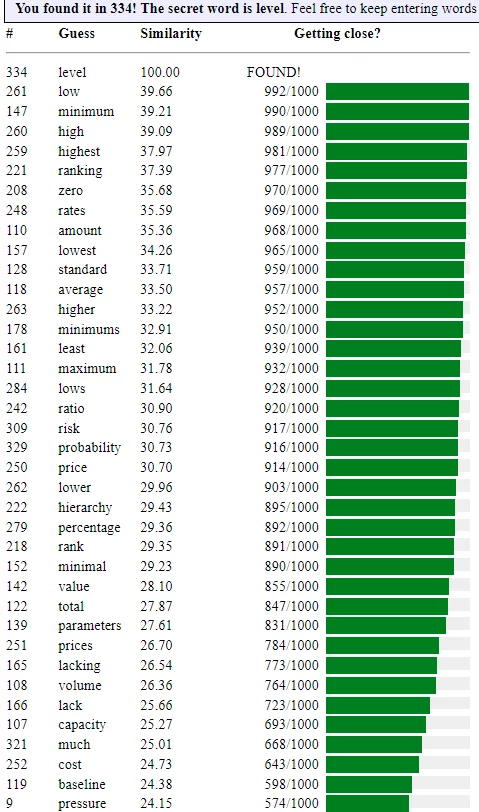
Reviewed as “brutal,” “like the Dark Souls of Wordle,” “hard mode,” and “God level difficulty,” Semantle won’t even give you the sweet release of death. Wordle is over in six turns, but here you try dozens, hundreds, thousands of guesses until you succeed or rethink every decision in your life. If not for the intensity of the craze that led any game ending with -le to find an audience for two months there, this atrocious grammarian would be as obscure as its own reasoning.
Still, there’s one redeeming feature to Semantle: it’s not bad in a way that really matters. Not like swastikas…or NFTs.
Worst Puzzle Feature of the Year: Planet Crossword/Hovercats, which supports free-to-play crosswords (good) and an interactive play-with-friends feature (great!) with sales of NFTs that “unlock digital ownership and perks for owners” (errr…) paid for by Ethereum (ERRRRR…).
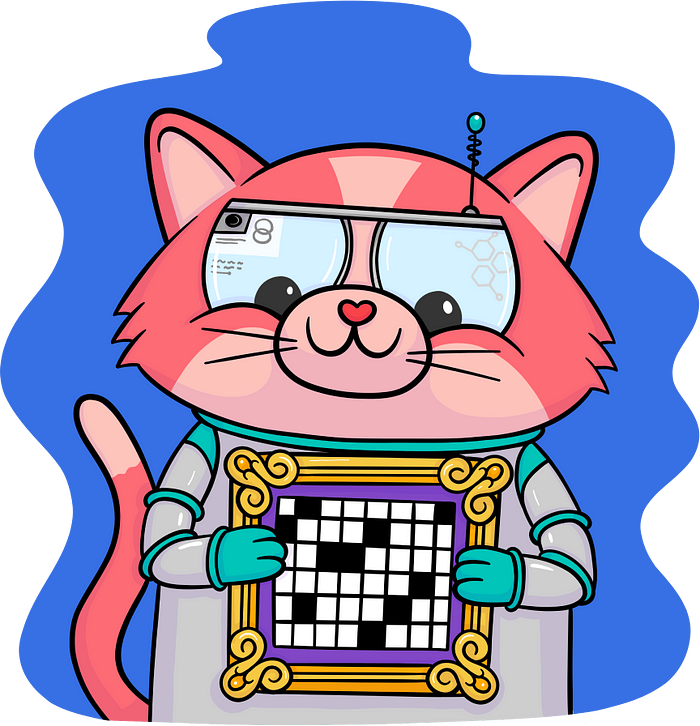
This time it’s not about the quality of the puzzles. I recognize that the makers of Planet Crossword recruited (and paid!) some great puzzlemakers — and that some opted out of direct involvement with the “crypto side” of the project. I’ve enjoyed their work elsewhere and wish them well.
But none of that changes the fact that any project tied to crypto and NFTs is a bad idea. Crypto has been a rich-get-richer scheme for a while now, a poor investment for the 99% despite its now-empty promises to improve on our system. NFTs are not only huge consumers of energy but also, in the long run, not worth the paper they’re not printed on. Either the puzzle can be played by many, in which case no one “owns” it — as is the case here — or it’s a private commission for one person, which isn’t as marketable.
Hovercats has promised to offset its carbon emissions with Aerial, but I have my doubts, and it’s provided no data to quiet those doubts. For more, I refer you to Rose Sloan, whose entire thread is worth reading.
Also worth noting is Norah Sharpe’s call for understanding of the crossworders involved in the project.
I can’t fault the creatives. I’ve taken money from employers who turned out to be sketchy in my day, too. (And I missed much bigger warning signs than Hovercats seems to have given.) But as Rose points out, “NFT projects exist purely to get you to buy cryptocurrency — which is at very best a highly volatile and unregulated investment. Everything else is window dressing.”

Whew. After all that heavy stuff at the end there, I need a distraction. Maybe a crossword mini, or some Wordle variant.
As long as it’s not “NFTWordle.” That doesn’t actually exist, does i —


You’re off the hook, Semantle!